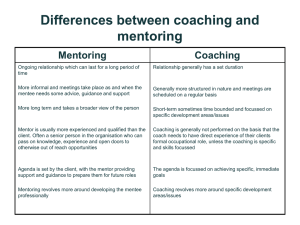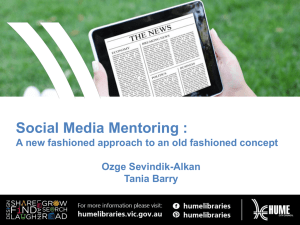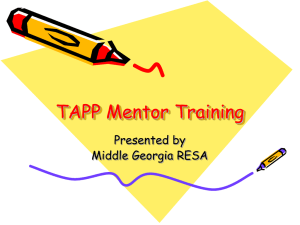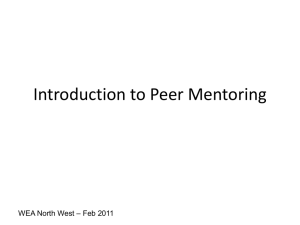Mentoring
advertisement
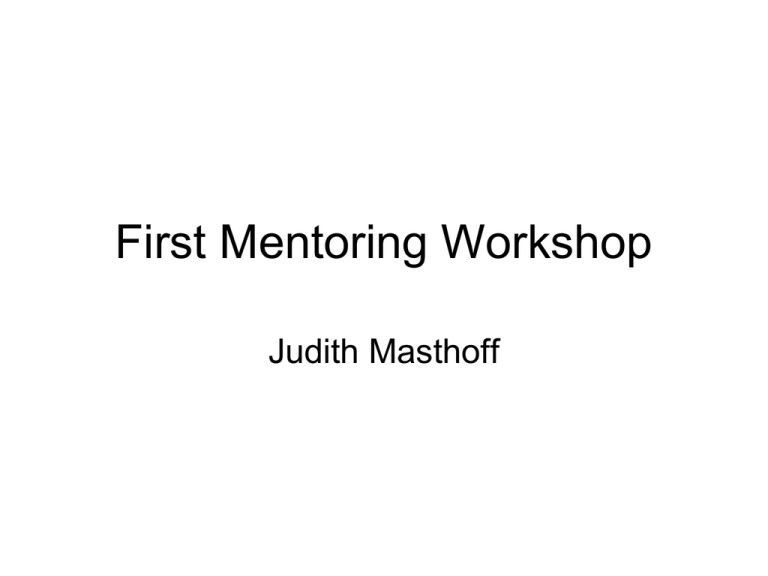
First Mentoring Workshop Judith Masthoff Admin issue: Mentoring slots Which of these slots can you make? Monday 3-4: Monday 3-4: Tuesday 12-1: Tuesday 3-4: Wednesday 1-2: Thursday 2-3: Friday 1-2: What is a mentor? • Write down some alternative words for ‘mentor’ • One word per post-it note Mentoring Roles • • • • • • Coach Role model Supporter Advocate Critical friend Acculturator (getting the mentee used to the culture) What is Mentoring? (1) ‘Behind every successful person, there is one elementary truth: somewhere, somehow, someone cared about their growth and development . This person was their mentor’ [Dr Beverley Kaye, Up is Not the Only Way, 1997] Mentorship refers to a developmental relationship between a more experienced mentor and a less experienced partner referred to as a mentee – a person guided and protected by a more prominent person. [Wikipedia] What is Mentoring? (2) To support and encourage people to manage their own learning in order that they may maximise their potential, develop their skills, improve their performance and become the person they want to be. [Eric Parsloe] What makes a good mentor? • Write down characteristics of a good mentor • One characteristic per post-it note Some Characteristics of a Good Mentor • • • • • • • • • • Approachable and welcoming Shares information and experiences openly Good communication skills Trustworthy, reliable Provides accurate and appropriate feedback Technical expertise Motivating, encouraging, positive and empowering Non judgmental Allocates appropriate time to mentoring Sensitive to the needs of the mentee Empowerment ‘ Mentoring is a process rather than an event; mentors must see themselves as managers of a process, rather than just passing on knowledge.’ (Galvin, 1998) Empowering the mentee • Communicate openly • Encourage them to take responsibility for achieving their goals • Give them space and time to complete tasks • Guide and counsel as they reach final stages of tasks • Help them to learn from mistakes • Help them to work out the answer, rather than just telling them • Give constructive, critical advice – but don’t expect to solve all their problems for them • Introduce them to other people who might be able to help them • Give them responsibility and monitor progress • Build confidence Foundations for successful mentoring relationships • Develop and communicate clear goals and expectations at the beginning • Set the ground rules and develop an agreement • Clarify the roles of the mentor and mentee • Work out when and how feedback will occur • Review the relationship at regular intervals Ground Rules • Which ground rules do you want? Provide Mentoring Support Establish a relationship Offer mentoring support 1. Assist mentee to identify and evaluate 1. Apply effective options to achieve agreed goals. communication 2. Share personal experiences and styles to develop knowledge with the mentee. trust, confidence and rapport 3. Encourage mentee to make decisions 2. Agree on how the relationship will be conducted 3. Clarify and discuss expectations and take responsibility for the courses of action under consideration. 4. Provide supportive advice and assistance in a manner which allows the mentee to retain responsibility for achievement of their own goals. 5. Change and discuss the mentoring relationship. 6. Make any adjustments to the relationship taking into account the needs of both mentor and mentee. Effective Mentoring Mentoring involves: • Level 1: a personal relationship in which a relative novice is supported by a more experienced peer in coming to terms with a new role • Level 2: active guidance, teaching and challenging of the mentee by the mentor, who accordingly needs to claim some expertise, wisdom and authority • Level 3: the management and implementation of a planned curriculum, tailored to the needs of the individual (McIntyre, 1996, p147) Coaching is… • a relationship and a conversation which supports a person to move forward to desired goals in a fulfilling manner (Myles Downey) • unleashing a person’s potential to maximise their own performance, it is helping them to learn rather than teaching them. The underlying intent of the coach in every coaching session is to build the self-belief, selfmotivation, choice, clarity, commitment, awareness, responsibility and ability of the coachee to take action (Sir John Whitmore) • proactive and focussed on solutions and the future Coaching Values • • • • • • • • • • Confidentiality Honesty Trust Openness Transparency Integrity Sincerity Equality Non-critical / non-judgemental Empathy / caring Core skills used in coaching • • • • Listening Questioning Other forms of communication Managing the process of coaching Listening "We were given two ears but only one mouth, because listening is twice as hard as talking." VS. Why be a good listener? Needs of the mentee… • • • • • • To be recognized and remembered To feel valued To feel appreciated To feel respected To feel understood To feel comfortable about a want or need The Purpose of Listening • • • • • To be present To accompany the other person on their journey Reflection of feelings To hold a mirror up of understanding To determine whether my sense of the other person’s inner and outer world is correct • To offer a non judgemental presence • Listening is NOT about asking questions or challenging what the other person is saying Levels of Listening 1. Cosmetic listening – listening in everyday conversation Listener looks as if they are listening but their mind is elsewhere Not useful in coaching People are usually aware that they are not being fully listened to Levels of Listening 2. Conversational listening A number of things are happening: listening, talking, thinking, planning what to say next Not useful in coaching Levels of Listening 3. Active or attentive listening The listener is very focused on what the speaker is saying, they are paying attention and recording significant facts The type of listening used in coaching It feels very positive to be listened to with someone’s full attention Levels of Listening 4. Deep listening The listener is more focused on the speaker than on themselves. The listener’s mind is “quiet” and the intention is “seeking to understand”. All the senses are being used. The ideal state for listening in coaching The client feels understood and may also experience a deeper connection to the coach Qualities of Active Listeners Desire to be “other-directed” No desire to protect yourself Desire to imagine the experience of the other Desire to understand, not critique Skills for Active Listening BODY LANGUAGE Examples: Sitting forward Eye contact Nodding head “You listen with your face as well as your ears!” Smile etc when appropriate Skills for Active Listening OPEN-ENDED QUESTIONS Examples: What happened after that? If you are not sure you understand what the speaker has said, just ask. Who was there? What did they do? How did that work? Skills for Active Listening REPEAT CONTENT Examples: So what I hear you saying is . . . It is a good idea to repeat in your own words what the speaker said so that you can be sure your understanding is correct. Skills for Active Listening ACKNOWLEDGING FEELINGS Examples: You’re feeling ___. It makes you (feeling) that . . . Skills for Active Listening DON’T JUDGE Examples: Bite your tongue! Skills for Active Listening BEING QUIET Examples: Count to yourself. Active Listening Body Language Open-Ended Questions Repeat Content Acknowledge Feelings Don’t Judge Be Quiet Other tips for being a good listener • Give your full attention on the person who is speaking. • Make sure your mind is focused too. • Let the speaker finish before you begin to talk. • Let yourself finish listening before you begin to speak! • Listen for main ideas. Exercise: Active Listening Split into trios (speaker, listener, observer) • Speaker – talk for 2 minutes about your experience of the first lectures this week • Listener – listen using the skills discussed • Observer – observe the application of the skills and take notes • Discuss how it went Do this three times, so that everybody has had a chance to practice listening Questioning • Questions are the main form of communication in coaching Open Questions • Questions that start with what, when, who, how many, how much • “Why” should be used with caution as it may imply criticism • “How” should be used with care as it may lead to analytical thinking • Open questions require descriptive answers. They raise awareness for both the coach and the client and promote responsibility in the client. The client creates a clear perception of the relevant facts and information and the ability to determine what is relevant. Creative thoughts and ideas are also stimulated and explored. Closed Questions • For instance: “Am I right?” • Limited use in coaching • Useful for checking when a yes or no answer is all that is required Questions which clarify • For instance, “If you take those steps, what will you achieve?” • These questions are used to make things clearer for both the coach and the client Enquiry questions • For instance, “What is your purpose in life?” • Enquiry questions require reflection and allow the client to explore their values, emotions, behaviour and reactions to an issue/situation (useful for homework) Incisive questions • For instance, “What would you do if you did not have to live with the consequences?” • Incisive questions are useful when the coach is working with the limiting beliefs of a client. These questions work to suspend the limiting belief and the client is able to see past the limitation Questions which challenge limiting beliefs • For instance, the client says “I always make a mess of projects at work”. The coach responds with “says who?” • Challenging questions are designed to raise the awareness of the client to help them move on Powerful questions • For instance: “What is stopping you from…?” • Powerful questions are usually brief and designed to help the client make a quantum leap in understanding and perception Use of appropriate questions What questions might be appropriate in the following situation? Situation: The mentee has difficulty articulating their needs/goals for the mentoring relationship. What questions might you, as the mentor, ask? Possible Questions: • What do you want to get out of this relationship? • Do you feel there is more that you are after from me as a mentor? If so, what? • How can I, as your mentor, better cater for your needs? • Can we discuss what you would like to accomplish by the end of the semester? Exercise: Questioning Split into trios (questioner, client, observer) • Questioner – ask questions • Client –answer questions • Observer – observe and take notes • Discuss how it went Do this three times, so that everybody has had a chance to practice questioning Other communication skills • • • • • Repetition Summarising Paraphrasing or reframing Grouping Making suggestions Repetition / Mirroring • Repeating back to the client words that they have said, often verbatim • Useful when there is an emotional undertone • For instance: “You find the lectures too difficult” “You feel discouraged.” Summarising • “Extracting the essence” from what the client has said • Not just facts but also feelings • Useful to check that the coach has fully understood the client • It also confirms to the client that he or she is fully understood • For instance: “These seem to be the main problems you’ve expressed…” Paraphrasing or reframing • The coach uses his or her own words to reflect or reframe back to the client something which he or she has said • This is to ensure communication is clear and meaningful in terms of intended outcomes • This may help the client to detach from issues, to create some distance and to provide new insights and ideas • For instance: “So you would like your friends to help you learn to program, is that right?” Grouping • Identification of the relationship between themes/elements in the conversation • This may help to raise awareness of the client to patterns or linkages which they have not previously recognised Making suggestions • The coach believes that he or she has something to offer which will add value • The coach may make a suggestion, but the client does not have to act on the suggestion • This can be useful when the client is stuck and has spent time reflecting and acknowledges that a suggestion would be helpful Managing the process of coaching TGROW model provides a structure • Topic • Goal What do you want to happen? • Reality What is happening now? • Options What could you do? • Will What will you do? Topic • Provides background and structure for the client and coach, and a common basis to take the session forward Goal Setting • What do you want to happen (establishes goal for the session) • Coach works with client to identify and agree on achievable outcomes Reality • What is happening now (who, what, where, how much) • Coach works with the client to generate a clear understanding and awareness of the current situation and the topic Options • What could you do? (What is possible?) • Coach draws out a range of options from the client encouraging creativity, acts as a “sounding board” (No evaluation or judgement of options) Will • What will you do? (Clarify commitment) • Coach works with client to select options, encouraging responsibility, commitment to action and creation of an action plan with an appropriate timescale and measures for reviewing progress. Mentoring Session 1: Getting Acquainted (1) Introduction • Tell the group your names, your year of study/degree you are on, and give them your email addresses. • Tell them that the purpose of the mentoring sessions is to help them get the most out of the course, by providing peer support (by you and by other members of their group) • Tell them that this first week will be mainly about getting to know each other • In discussion with the group, establish ground rules • Tell them that you will treat what they tell you with confidentiality (in the sense that you will only report opinions of the group without highlighting individuals). Ask them to treat each others remarks with confidentiality as well. Tell them that once in a while a lecturer may attend a mentoring session. • Tell them that you would like them to attend all sessions, and sent you an email when they cannot make it Mentoring Session 1: Getting Acquainted (2) Activity 1: Interviews Aims: To begin to get to know one another, to develop confidence, to develop awareness of membership of a group Procedure • Get the group to brainstorm what they would like to know about each other in the context of this group. Display the headings on the blackboard. (Could include past programming experience, what they did before they came to uni, which country they are from, their name, etc etc, leave this up to the group). Spent about five minutes on this. Mentoring Session 1: Getting Acquainted (3) • In pairs, one person interviews the other to gather this information (and anything else that the two think of and wish to share). Spent about five minutes on this. You may want to take part yourself (and one of you will have to if the number of students is odd) • Interviewers remain where they are, while interviewees move round and interview someone that they have not previously met. Again, about five minutes. • Everyone prepares (organizes their notes, etc) to introduce the person they interviewed. About 2 minutes. • In turn, individuals address the group, introducing the person that they interviewed. About 2 minutes per person. Mentoring Session 1: Getting Acquainted (4) Activity 2: Views on first lectures • Ask the group what they thought of the first lectures. Were they too easy/too difficult? What things were the most difficult to understand? Keep a diary • After the mentoring session, spend fiveten minutes to write down your impressions: – How did it go? – What did you find difficult? – What were the main things you learned?
